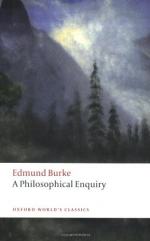
|
| Name: _________________________ | Period: ___________________ |
This quiz consists of 5 multiple choice and 5 short answer questions through Part III, Sections I - VIII.
Multiple Choice Questions
1. What does Burke use as an example of difficulty as greatness?
(a) Stonehenge.
(b) The Great Wall of China.
(c) Roman aqueducts.
(d) The Pyramids of Egypt.
2. Why, according to Burke, is proportion not the cause of beauty in animals?
(a) Because beauty relies upon the relative length, width, and height of the object.
(b) Because our idea of proportion is so clear and obvious as to preclude the beautiful.
(c) Because all species of animals have different proportions, yet we as a society deem them beautiful.
(d) Because proportion and geometry can only be discussed in reference to architecture.
3. How do sublime buildings look, according to Burke?
(a) Heavily built.
(b) Architecturally balanced.
(c) Dark and gloomy.
(d) Light and airy.
4. What does Burke criticize about the patrons of proportion?
(a) That they have not expanded their architectural projects enough.
(b) That they view their own works and views as superior to nature.
(c) That they are disproportionate and ugly.
(d) That they are not clear enough in defining proportionality.
5. What, according to Burke, affects the passions and most incites admiration?
(a) That with which we are closely acquainted.
(b) That which is human made and manufactured.
(c) That which we know little or nothing about.
(d) That which can be explained in lay terms.
Short Answer Questions
1. What passion does Burke identify as most effectively robing the mind of reasoning?
2. Burke asserts that vastness of dimension is as sublime as:
3. To which human faculty does Burke opine proportion belongs?
4. To what is deformity opposed, according to Burke?
5. In Burke's opinion, at what depiction do painters most notably fail?
|
This section contains 312 words (approx. 2 pages at 300 words per page) |

|




